14 April 2022
Ideas to start with...

There are many advocates of social media in education, but I would not have classed myself as one of them until recently. For some time now I’ve enjoyed what I call my Sunday morning ‘Twitter Trawl’ where I actively seek out favourite hashtags (such as #caschat, #forestschool, #eyfstalking, #eyfstwitterpals, #EYFS, #AppleEDUchat) and accounts to see what ideas might be magpied and recycled. All it takes sometimes is an image of a display or someone’s classroom or a child’s work and a flash of inspiration hits me:
I could do that! That would work well with… This would be great for…
And I’m set up for planning, preparing and creating my next lesson, resource or display. I like to think of it as collaboration at its best, because I can do it lying in bed in my PJs! That said, I do love meeting with other teachers in person and sharing ideas, but when time is so precious and pressured this isn’t always possible, so Twitter is my next best thing.
The Computing At School community has also been totally amazing at helping me develop the necessary skills and subject knowledge to lead Computing. (And this was before their new toolkit for Computing Leads that you can check out here!) I would leave their free CPD sessions armed with ideas and resources that I would then try to replicate exactly in my classroom or Code Club (which I also started as a result of some CAS input). This was great to begin with and the children loved it when I came back and said “yesterday I learnt to… so today you’re going to have a go at…!” However, there was very little carefully considered progression in this approach and it certainly didn’t make for a well-planned curriculum! BUT it got me started on a journey that, seven years down the line, is seeing real positive outcomes.
Rather than just taking someone else’s idea and trying to replicate it exactly in my own classroom, I’m able to adapt and change the content to fit my context, without diluting the concept or the core learning objective. This has become particularly useful when adapting and delivering the new NCCE Computing curriculum in KS1 and KS2. I now realise this is the result of my increased confidence that has come about through my improved subject knowledge. So while ‘off the shelf’ ideas are still very useful, I believe it’s even more important to continue building-up practitioners’ subject knowledge so they can take these ideas and adapt them for their own purpose.
When it comes to developing algorithmic thinking and early programming concepts in EYFS, the Barefoot Computing resources are superb and a great starting point for anyone, especially if they're not feeling confident in this area. An example of how something I saw on Twitter from Allen Tsui sparked an idea for adapting one of the Barefoot Springtime resources can be seen in this Jamboard I created. Using Allen’s idea of creating a PDF for the background of the Jamboard and then using the Barefoot images for the algorithm to plant a seed, I created a sequencing activity that could be completed on our interactive whiteboard. (With the added bonus of no lost images and glue nightmare for some children!)
This then sparked an idea for another resource (called Ideas to start with...) I could create to support others in developing the use of algorithms and early programming concepts in EYFS, largely based on what I’ve been doing with a Twister mat in my classroom. I hope you find it useful and it encourages you to have a go at using a story you are currently reading with your children to develop their understanding of algorithms and early programming concepts, even if you don’t go anywhere near a piece of technology! And if you do have a story to add to the list, then you can post your ideas here to add to the collection.
Happy magpie-ing!








Discussion
Please login to post a comment
Oh what a shame but I bet they really enjoyed it! Can’t beat a set of sparkly hats! Great for binary code too!
Ordering the algorithm went well with the hats, but as for the actual bird feeders… well… process over product ;o)
Of course I would give it a five star rating. Thank you for tagging me into the article! For anybody scrolling by who wants to find out more about how Jamboard enables EYFS learners to meet the targets of “using simple software to make something happen” as well as “making choices about the buttons and icons I press, touch or click on” there follows a link to an example. Please save to your Google Drive for full editing rights Hokey_Cokey_song_20220414 - Google Jamboard
Brilliant! Please let us know how it goes!
Thanks, Jo. I love the ‘hats’ idea! This is definitley a good way to get them up and about, moving around and physically thinking about the order of the algorithm. I’m going to try it with the making a bird-feeder activity next week :o)
Thanks for the insights as usual Rachael! I took the plunge into EYFS and delivered the seeds session with some adaptions. The Reception teachers had planted some sunflower seeds before, so my session consolidated their understanding. Think this way worked well! I made hats with the cards on for the pupils to put on and then we checked our algorithm by planting a child- sized seed! Great fun and would recommended the resources!
The final (internal) link appears not to be working so I’m posting it here to link to the resource creted with the same name as this blog post… Ideas to start with...